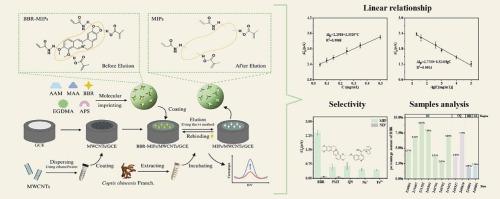A molecularly imprinted polymer-based electrochemical sensor for highly selective and sensitive Berberine detection in complex herbal samples
IF 4.9
2区 化学
Q1 CHEMISTRY, ANALYTICAL
引用次数: 0
Abstract
Electrochemical analytical techniques are increasingly used to determine active ingredients in traditional Chinese medicine due to their rapid response, precision, and high sensitivity. However, the specificity of electrochemical sensors in recognizing target molecules during detection has been suboptimal, limiting their broader use in the analysis of complex herbal medicine samples. To address this issue and enhance the specificity of detection, a novel electrochemical sensor was developed, utilizing molecularly imprinted polymers (MIPs) as the sensor's recognition element for the quantification of Berberine (BBR). Berberine molecularly imprinted polymers (BBR-MIPs) were synthesized with BBR as the template molecule, alongside acrylamide and α-methacrylic acid as bifunctional monomers, facilitating selective adsorption and detection of target molecules. Furthermore, multi-walled carbon nanotubes (MWCNTs) were used as sensitizing materials and carriers to modify the glassy carbon electrode (GCE). Under optimized experimental conditions, the sensor demonstrated a wide detection range (1.0 × 10−5 mg/mL ∼ 0.5 mg/mL) and a low detection limit (2.0 × 10−8 mg/mL) for BBR. The sensor was characterized by its simplicity, sensitivity, selectivity, and stability, and had been successfully applied to the detection of BBR in real Coptis chinensis Franch. samples. This provided a method with promising application prospects for the rapid quality evaluation of related Chinese medicines and enhanced the reliability of related Chinese medicines and their compound formulas in clinical applications.

一种分子印迹聚合物电化学传感器,用于复杂草药样品中小檗碱的高选择性和高灵敏度检测
电化学分析技术以其快速、准确、灵敏等优点,越来越多地应用于中药有效成分的测定。然而,电化学传感器在检测过程中识别目标分子的特异性并不理想,限制了它们在复杂草药样品分析中的广泛应用。为了解决这一问题并提高检测的特异性,开发了一种新型电化学传感器,利用分子印迹聚合物(MIPs)作为传感器的识别元件来定量测定小檗碱(BBR)。以小檗碱为模板分子,以丙烯酰胺和α-甲基丙烯酸为双功能单体,合成了小檗碱分子印迹聚合物(BBR- mips),促进了靶分子的选择性吸附和检测。此外,采用多壁碳纳米管(MWCNTs)作为增敏材料和载体对玻碳电极(GCE)进行修饰。在优化的实验条件下,该传感器对BBR具有较宽的检测范围(1.0 × 10−5 mg/mL ~ 0.5 mg/mL)和较低的检测限(2.0 × 10−8 mg/mL)。该传感器具有操作简单、灵敏度高、选择性好、稳定性好的特点,已成功应用于黄连中BBR的检测。样本。为相关中药的快速质量评价提供了一种具有良好应用前景的方法,提高了相关中药及其复方在临床应用中的可靠性。
本文章由计算机程序翻译,如有差异,请以英文原文为准。
求助全文
约1分钟内获得全文
求助全文
来源期刊

Microchemical Journal
化学-分析化学
CiteScore
8.70
自引率
8.30%
发文量
1131
审稿时长
1.9 months
期刊介绍:
The Microchemical Journal is a peer reviewed journal devoted to all aspects and phases of analytical chemistry and chemical analysis. The Microchemical Journal publishes articles which are at the forefront of modern analytical chemistry and cover innovations in the techniques to the finest possible limits. This includes fundamental aspects, instrumentation, new developments, innovative and novel methods and applications including environmental and clinical field.
Traditional classical analytical methods such as spectrophotometry and titrimetry as well as established instrumentation methods such as flame and graphite furnace atomic absorption spectrometry, gas chromatography, and modified glassy or carbon electrode electrochemical methods will be considered, provided they show significant improvements and novelty compared to the established methods.
 求助内容:
求助内容: 应助结果提醒方式:
应助结果提醒方式:


